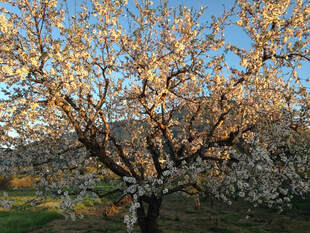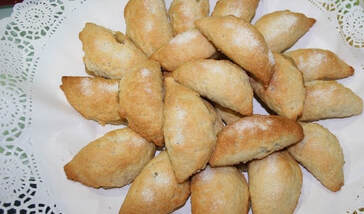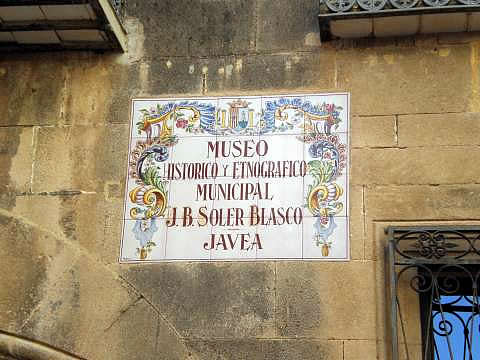|
The almond trees, which we are so familiar with in our region, were first brought here in approximately 800 BC. Originally from Central and Western Asia, it was the Phoenicians and later the Greeks who brought them to the Iberian peninsula. However it was only from the Arab period onwards (8th century ) that almond trees were properly cultivated. The Arabs brought with them their tradition of confectioneries made from almonds and honey or sugar, which later became the basis for several different sweetmeats such as turon, pastissets and almendrados. Being robust and hardy, the almond tree was well suited to the poor soil of large parts of the coastal region. In fact the Comunitat Valenciana is the third largest almond-producing region in Spain - and Spain is the world´s second largest producer after the USA. Traditionally most families in Xàbia had at least one small almond plantation for their own consumption, with the surplus being sold. The fruit was harvested in mid August and already everyone looked forward to Christmas time, when almonds were ground and made into delicious sweet treats. Here are a few traditional recipes that I got from the charming mother of a friend in Xàbia : -Pastissets de almendra al viento : (these are not baked but air-dried) 2 eggs, 1/2 kg ground almonds,1/2 kg sugar. Mix ingredients and knead. Roll into balls and flatten them. Fill with sweetpotato jam and close to form the typical half-moon shape. Place on a tray and leave to dry in cool dry place for approximately 2 weeks. -Pastissets de almendra (baked) : 2 eggs, 1/2 kg ground almonds, 250g sugar. Mix ingredients and continue as in the above recipe. Put the tray of half-moon shapes into low heat oven to bake slowly for approximately 30 minutes. -Pelota dulce : 1/2 kg ground almonds, 50g lard or more if desired, sugar to taste, a little sweet potato jam, cinnamon, lemon zest, pine kernels, a little bread crumbs, 1 egg. Mix all ingredients and form into one oval mass to be put into the Christmas puchero in its last cooking phase. -Casca : this is a Valencian speciality which is baked for the Epiphany or 3 Kings Day on 6th Jan. The Casca has the same ingredients as the baked almond pastissets, but has the form of a ring and is covered with sugar before baking. After baking the sugar makes a delicious crunchy coating. For those who have no time or inclination for baking, this speciality can be bought in one of Javea´s favorite bakeries : Diego´s. Unfortunately, there is some bad news for the almond tree. In 2016 the highly infectious pathogenic bacterium Xylella fastidiosa, which is spread by insect vectors, started killing hundreds of almond trees in Mallorca. The disease is now on the mainland and since 2017 has been found in various places in the Comunitat Valenciana, with Javea being partially affected. Although so far there is no antidote, the authorities and scientists are working hard to find solutions as soon as possible. Christmas just wouldn´t be the same without pastissets ! AMUX wishes everyone a happy and delicious festive season !
0 Comments
|
ACTIVITIES
Categories |
- Home
- Blogs
-
Projectes
- Premio de Investigación - Formularios de Inscripción
-
Traducciones Translations
>
-
DISPLAY PANELS - GROUND FLOOR
>
- THE STONE AGES - PALAEOLITHIC, EPIPALAEOLITHIC AND NEOLITHIC
- CAVE PAINTINGS (ARTE RUPESTRE)
- CHALCOLITHIC (Copper) & BRONZE AGES
- THE IBERIAN CULTURE (THE IRON AGE)
- THE IBERIAN TREASURE OF XÀBIA
- THE ROMAN SETTLEMENTS OF XÀBIA
- THE ROMAN SITE AT PUNTA DE L'ARENAL
- THE MUNTANYAR NECROPOLIS
- ARCHITECTURAL DECORATIONS OF THE PUNTA DE L'ARENAL
- THE ATZÚBIA SITE
- THE MINYANA SMITHY
- Translations archive
- Quaderns: Versión castellana >
- Quaderns: English versions >
-
DISPLAY PANELS - GROUND FLOOR
>
- Catálogo de castillos regionales >
- Exposició - Castells Andalusins >
- Exposición - Castillos Andalusíes >
- Exhibition - Islamic castles >
- Sylvia A. Schofield - Libros donados
- Mejorar la entrada/improve the entrance >
-
Historia y enlaces
-
Historía de Xàbia
>
- Els papers de l'arxiu, Xàbia / los papeles del archivo
- La Cova del Barranc del Migdia
- El Vell Cementeri de Xàbia
- El Torpedinament del Vapor Germanine
- El Saladar i les Salines
- La Telegrafía y la Casa de Cable
- Pescadores de Xàbia
- La Caseta de Biot
- Castell de la Granadella
- La Guerra Civil / the Spanish civil war >
- History of Xàbia (English articles) >
- Charlas y excursiones / talks and excursions >
- Investigacions del museu - Museum investigations
- Enllaços
- Enlaces
- Links
-
Historía de Xàbia
>
- Social media
- Visitas virtuales
- Tenda Tienda Shop




 RSS Feed
RSS Feed
